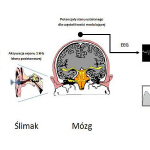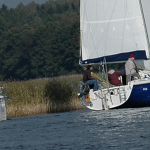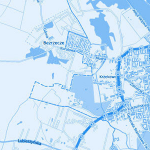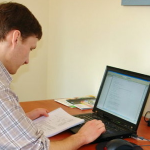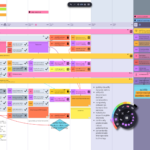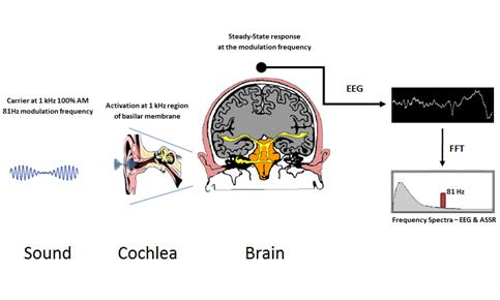
MASTER II – ASSRs based system for hearing assessment

Auditory steady-state evoked responses (ASSRs) consist of an electrical waveform whose frequency components remain constant over time in amplitude and phase. They are produced when the stimuli are presented to an ear at a rapid enough rate to cause the brain response from one stimulus to overlap the response to the preceding stimulus. The potentials from these overlapping stimuli become the steady-state response (John, Lins, Boucher, and Picton, 1998). Not only pure tones but also the sinusoidal modulation of the amplitude or frequency of a continuous carrier frequency may also be used to evoke steady-state responses. This technique results in a response containing frequencies at the rate of stimulation/modulation and/or at harmonics of this rate (stimuli activate the cochlear region that corresponds to the carrier frequency, the ear and auditory pathways cause each tone to evoke a response at the modulation frequency)
The MASTER II system simultaneously generates multiple amplitude-modulated, AM2 and/or frequency-modulated auditory stimuli, acquires electrophysiological responses to these stimuli, displays these responses in the frequency-domain, and determines whether or not the responses are significantly larger than background electroencephalographic activity. When the ear hears the tone, response occurs at the frequency of the carrier tone (stimuli activate the cochlear region that corresponds to the carrier frequency). When the ear hears the modulation of the tone, response occurs at the frequency of the modulation rate (ear and auditory pathways cause each tone to evoke a response at the modulation frequency).
It is assumed that the part of the cochlea that is being stimulated by the carrier frequency (i.e. 1000 Hz) must be intact to respond to the amplitude modulation rate (i.e. 81 Hz) producing a response. The scalp-recorded activity contains the multiple superimposed responses to the various stimuli – the amplitude and phase of the response to each stimulus can be measured at the specific frequency at which the tone was modulated. Hearing level at carrier frequency can be assessed by measuring the response for modulation frequency..
Features:
The MASTER II includes both software and hardware and requires a PC station running Windows OS to collect and analyze auditory steady-state responses. The system is based upon the work of T.W. Picton, M.S. John and others at the Rotman Research Institute in Toronto Canada.
The MASTER II user can print out the results, store the data on disk and review the stored data. The system design follows clear principles concerning the generation of acoustic signals, the acquisition of artifact-free data, the analysis of electrophysiological responses in the frequency-domain, and the objective detection of signals in noise.
- Data management – database including patient demographic data and test data (general information, protocol, analyzes history and results) and binary files (row EEG)
- Stimuli generation – stimulation protocols, sequences, stop criteria
- Collection – collection protocols, collection control (pause, stop, etc…), impedance measurement and control
- EEG – review, analysis and recording in binary files (for further review and analysis)
- Analysis – the real-time analysis of electrophysiological responses in the frequency-domain (F-ratio of significance), spectra, audiogram. Off-line analysis of the EEG recorded including manipulations in analysis’ parameters
- Reports – printing customizable reports including patient demographic and test data
- Hardware self diagnostics
MASTER II allows collecting and analyzing multiple frequencies at same time – making the test faster, its stimuli has less spectral splatter; therefore, it more frequency specific. Higher intensities allow for increased information with patients with severe and profound losses.
Example screens:
How it works:
ASSR is an electrophysiological response, similar to ABR. MASTER II instrumentation includes insert earphones, surface electrodes and averaging computer. Stimuli are pure tones (frequency specific, steady state signals) activating cochlea and CNS. ASSR is generated by rapid modulation of “carrier” pure tone amplitude (AM) or frequency (FM). Signal intensity can be as high as 120 dB HL. ASSR phase or frequency is detected automatically.
Gui Layer
- Main Window – it displays a title bar and menu bar, standard toolbars and a status bar at the bottom. Main frame window is responsible for managing all child windows and GUI components
- Patient/Test Open Dialog – the module responsible for searching, filtering and opening patients and tests associated with them
- Ear Data Tables – collection and analysis windows – display information during data collection or review (carrier frequencies, modulations, individual spectra, response amplitude, noise and p-value)
- Amplitude Spectrum – GUI component that is used to display FFT data
- EEG Graph – it is used to observe epoch data received during collection (replay) and to define artifact rejection level for collection
- Impedance Table – component responsible for presenting impedance test information
- Audiogram – it displays audiogram data during collection or collection-replay
- Protocols Setup Dialog – module created to present, add and edit collection protocols and their parameters
- Collection Control Dialog – the module is responsible for controlling collection and analysis processes
- Reports – external application responsible for providing customizable reports.
Business login layer
- Internal Data Storage – holds all data that are displayed in Collection/Analysis Windows. The module is responsible for informing all data visualization modules that some data have been changed and they must be refreshed
- Analyzer – it is intended for calculating any statistics needed in MASTERII application
- Collection Control – module responsible for managing collection; it processes commands, checks test stop conditions and handles sequences
- Patient/Test Data Manager – holds and manages all patient’s and tests’ data
- Protocols Manager – the module that saves/reads collection protocols to/from database and holds current protocol
- Configuration Manager – the module that saves/reads the configuration data used in the application
- Communication Thread – worker (collection) thread, that is responsible for performing collection (and other operations connected with hardware)
- DB Access – the module responsible for communication with databases
- Files Manager – the module responsible for creating/reading/saving raw data, checking file name uniqueness
- HW Manager – high level driver responsible for the communication with hardware unit (opening port, sending collection’s parameters, downloading raw data).
Other layers
- Binary File – binary file that is used to store raw data EEG buffers
- Database – relational database including DB objects responsible for storing patient and test data, protocols, configurations and relations between them
- Communication Drivers – USB and RS232 drivers providing support for communication between averaging unit and PC station.
Project
- Development environment:
- DSP side – Visual DSP++; hardware Apex-ICE debuger
- PC side – Visual Studio 2003, Component One GUI components
- Programming language:
- DSP side – assembler
- PC side – C++
- Size: 150 man-months
















